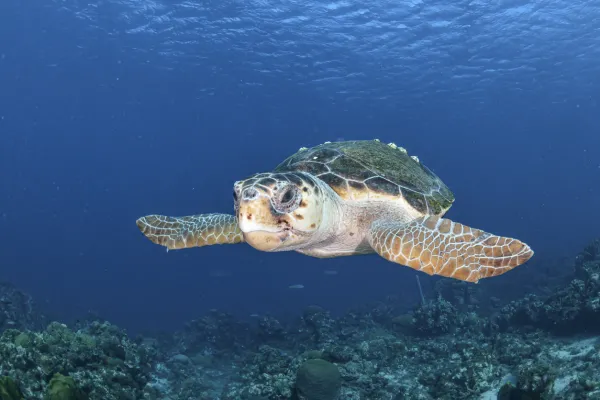The loggerhead is one of the most widespread sea turtles, occurring in the Pacific, Indian, and Atlantic Oceans and the Mediterranean. Yet multiple human-driven pressures—coastal tourism, bycatch, poaching, marine pollution, habitat loss, and climate change—have driven long-term declines. The species is listed as Vulnerable on the IUCN Red List and protected under regional and international agreements (e.g., EU Habitats Directive, Barcelona Convention, CMS for migratory species).

The six key threats
Species traits & ecology
What works: measures to prevent extinction
FAQs (quick answers)
Key takeaways & action checklist
Timing overlap: Nesting occurs mainly in summer—peak tourist season—so beach traffic, grooming, noise, and artificial light reduce nesting success.
Physical barriers: Daytime furniture (umbrellas, loungers), sand pits, and especially vehicles on beaches block females and disorient hatchlings; nests risk trampling.
High-risk gears include trawls, drift nets, longlines, and vertical lines, causing entanglement, drowning, or severe injury.
In several nesting/foraging corridors, bycatch is considered a primary driver of population declines (e.g., strong drops reported in some Atlantic rookeries).
In some areas, turtles are taken for meat or skin, and eggs are illegally harvested for consumption, directly removing breeders and future recruits from the population.
Entanglement in abandoned nets/ropes and plastic packing strips causes injury, amputation, or death.
Ingestion of plastics (bags, balloons, fragments) blocks the gut or reduces body condition and reproductive output.
Exposure to oil and persistent contaminants can affect immunity and reproduction.
Coastal hardening (seawalls, groynes), sand mining, and altered sediment supply shrink and reshape nesting beaches.
Light pollution from waterfront buildings and roads causes misorientation of hatchlings away from the sea.
Degraded coastal waters and seafloors reduce foraging habitat quality.
Temperature-dependent sex determination (TSD): Warmer incubation sands skew sex ratios toward females; extreme heat can kill embryos.
Sea-level rise & stronger storms increase nest flooding and erosion, lowering hatching success; shifting rainfall patterns also affect embryo survival.

Appearance & size: Among the larger Cheloniidae turtles; large head, powerful jaws; carapace usually reddish-brown above, yellow below.
Diet & role: Primarily carnivorous, feeding on benthic invertebrates (mollusks, crustaceans). Foraging disturbs sediments, influencing benthic communities; the shell often hosts epibionts (a small “moving habitat”).
Reproduction:
Age at maturity: roughly 10–37 years (varies by region).
Nesting behavior: Strong natal homing to birth beaches. In a single season, a female lays 3–5 clutches (each 40–190 eggs), with 12–23 days between clutches; she typically nests again after 2–3 years.
Distribution & movements: Widespread in temperate to subtropical coastal waters; common in the Mediterranean (e.g., Greece, Türkiye, Israel, Libya). Highly migratory, tracking warm currents such as the Gulf Stream and the California Current.
Vulnerability: Especially prone to incidental capture in nets and on lines worldwide.
Dark-sky beaches: Replace or shield lights, set curfews, and reduce night activity to prevent disorientation.
Clear obstacles & ban vehicles: Remove furniture and fill pits daily; prohibit beach driving; fence or mark known nest zones.
Professional monitoring: Trained staff/volunteers conduct nest surveys, marking, and hatch-period guarding; relocate at-risk nests only under expert protocols.
TEDs (Turtle Excluder Devices) on trawls to let turtles escape.
Longline improvements: Use circle hooks, adjust bait, depth, and set times, and follow rapid de-hooking and release best practices.
Time–area management: Seasonal or dynamic closures in high-risk hotspots (migratory corridors, peak nesting seasons).
Design representative MPAs across key nesting, migratory, and foraging sites (e.g., Mediterranean, South Africa, Madagascar, Australia) and coordinate transboundary management.
Source reduction: Single-use plastic limits; recycling; gear buy-back/deposit programs.
Cleanup: Regular beach and harbor cleanups.
Enforcement: Penalties for illegal gear dumping.
Strengthen national/local legal protection and enforcement.
Follow integrated models (e.g., NOAA in the U.S.) that combine monitoring, legislation, international cooperation, and fishery practice changes.
Population tracking: Nest counts, mark–recapture, satellite telemetry, and genetics.
Climate impact studies: Link sand temperatures, rainfall, and storms to sex ratios and hatching success.
Gear innovation: Ongoing R&D on low-bycatch technologies and global population monitoring.
Viewing guidelines: Keep safe distances; do not touch or feed turtles; avoid bright lights on nesting females and hatchlings.
Report emergencies: Contact local rescue centers for injured, stranded, or entangled turtles.
Get involved: Volunteer for nesting-beach patrols and cleanups; donate to vetted conservation groups.

When do loggerheads nest?
Mostly in summer nights. A female lays 3–5 clutches per season, 40–190 eggs each, roughly 12–23 days apart.
Why is artificial light so harmful?
Hatchlings orient to the brighter ocean horizon and wave cues. Shore-side lighting reverses that gradient, causing fatal misorientation.
How does warming shift sex ratios?
With TSD, warmer nests produce more females; extreme heat reduces hatching success.
How do loggerheads differ from other sea turtles?
They have a large head and strong jaws suited to crushing hard-shelled prey; carapace reddish-brown; they thrive in warm-temperate zones.
Top threats: Tourism pressure, bycatch, poaching/egg theft, marine debris, habitat loss, climate change.
Core traits: Large head, powerful bite; mostly carnivorous; natal homing; maturity 10–37 yrs; 3–5 clutches of 40–190 eggs.
What works: Dark-sky + no-vehicle beaches, TEDs & circle hooks, MPA networks, plastic reduction & cleanups, long-term monitoring, and responsible wildlife viewing.
What you can do today
Support/volunteer with beach-nesting patrols and rescue centers.
Reduce plastics, recycle, and never release balloons.
Choose seafood from verified, turtle-safe fisheries.
On vacation, follow low-light, no-disturbance rules.
Report injured or entangled turtles to local authorities immediately.
animal tags: loggerhead sea turtle
We created this article in conjunction with AI technology, then made sure it was fact-checked and edited by a Animals Top editor.